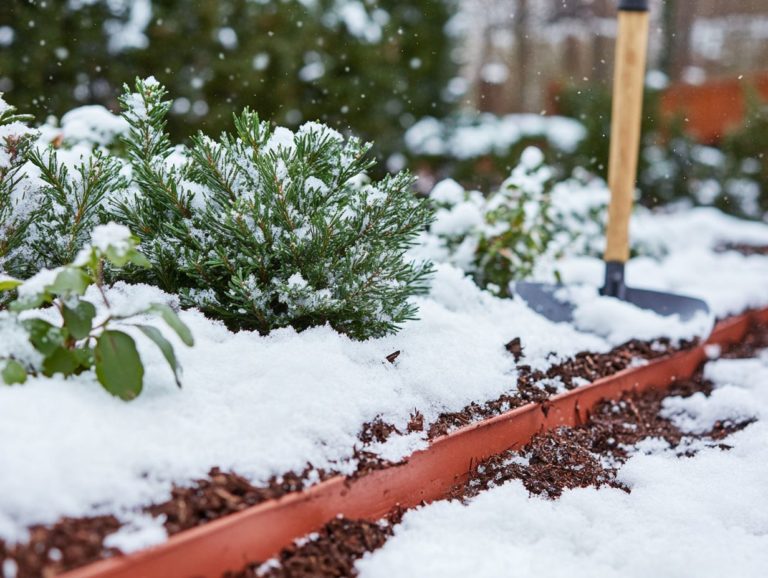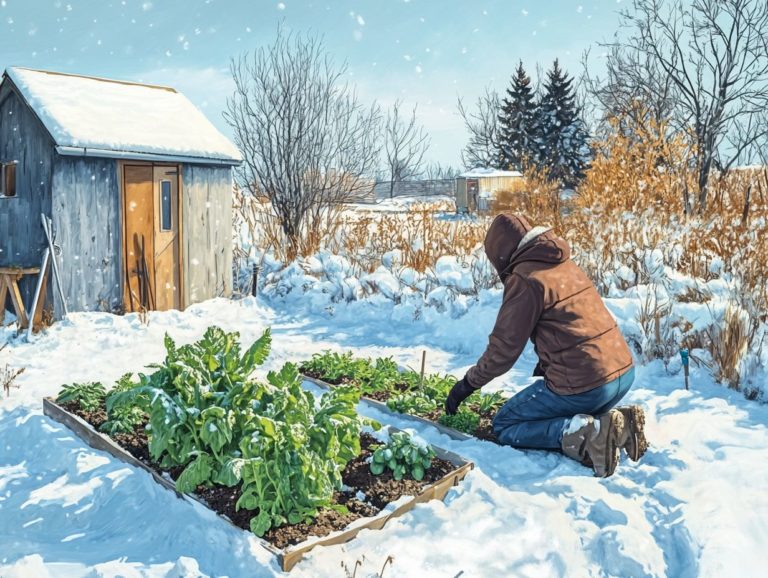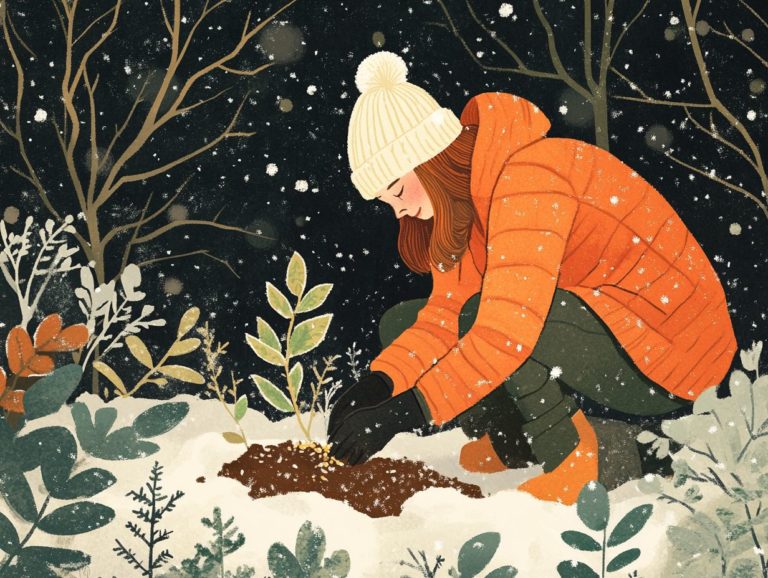Identifying Common Winter Plant Diseases
Get ready to tackle winter plant diseases! Understanding them is key to a thriving garden, especially with biting cold temperatures and a variety of diseases that can flourish.
Being informed about winter plant diseases is essential for maintaining vibrant gardens and landscapes, particularly for stone fruits like cherry trees and peach trees. This article explores various types of fungal, bacterial, and viral diseases such as damping-off disease and fusarium wilt that can impact your plants during this season.
You’ll learn to identify the signs and symptoms of these ailments while discovering effective strategies for prevention and treatment.
By equipping yourself with this knowledge, you can ensure that your plants not only survive but thrive throughout the winter months.
Contents
- Key Takeaways:
- Understanding Winter Plant Diseases
- Common Types of Winter Plant Diseases
- Signs and Symptoms of Winter Plant Diseases
- Preventing and Treating Winter Plant Diseases
- Frequently Asked Questions
- What are common winter plant diseases, including downy mildew and black spot?
- How can I identify common winter plant diseases like a dusty white coating on leaves?
- What is powdery mildew, characterized by a dusty white coating, and how do I treat it?
- How can I prevent gray mold, often seen on woody shrubs?
- Are there any natural remedies for winter plant diseases, including organic fungicides?
- How can I protect my plants from winter diseases, avoiding light green patches and pale green spots?
Key Takeaways:
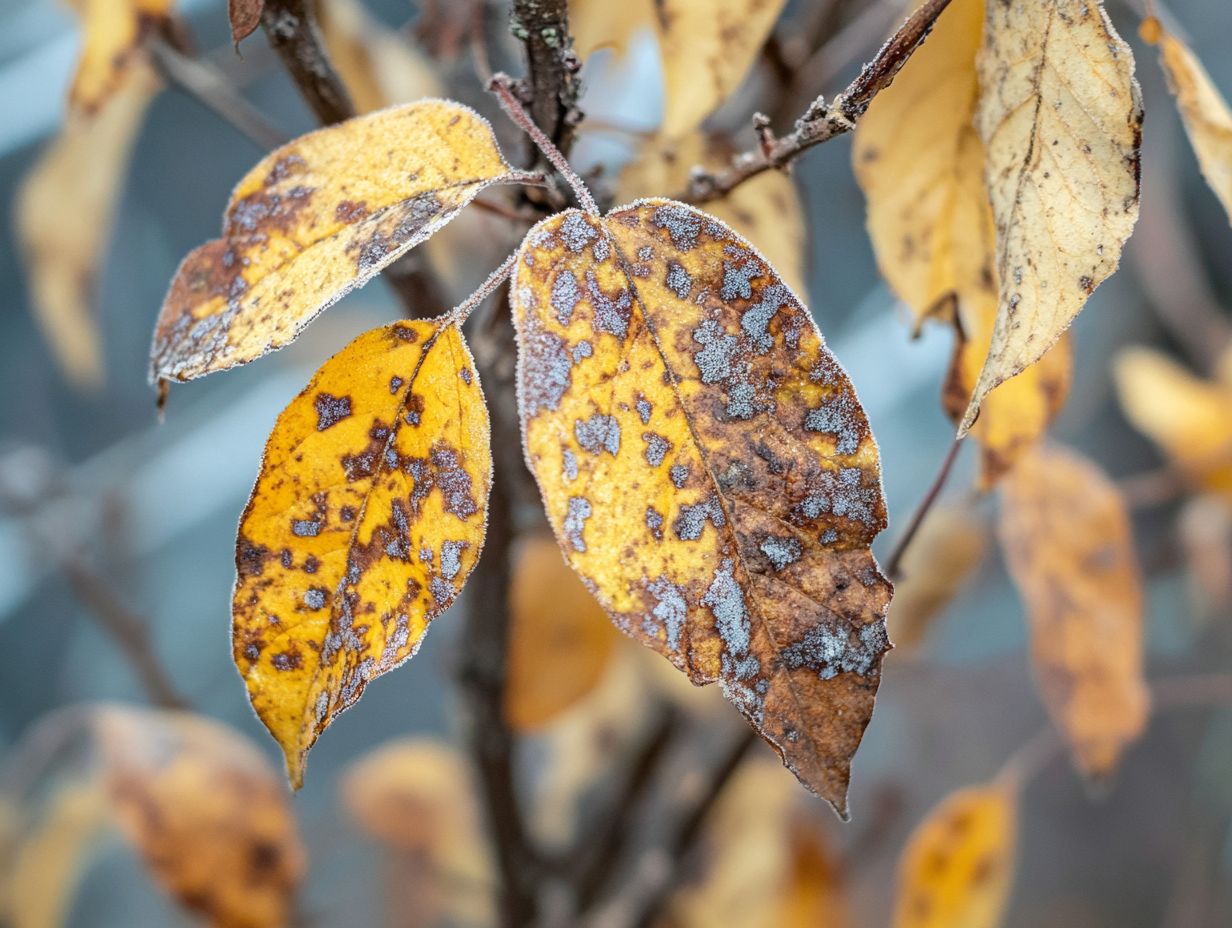
- Identify common winter plant diseases: Learn about fungal, bacterial, and viral diseases that can affect plants during the winter season.
- Spot the signs: Look for visual indicators to catch issues early and prevent winter plant diseases.
- Prevent and treat diseases: Use effective strategies for prevention and consider treatment options for infected plants to keep your winter garden thriving.
Understanding Winter Plant Diseases
Understanding winter plant diseases is essential for preserving the health of your gardens and crops during the colder months. Various diseases can thrive in these conditions, potentially wreaking havoc on plants like cherry trees, peach trees, and other stone fruits.
Being aware of common plant diseases allows you to spot issues early and implement effective management practices for both prevention and treatment. Recognizing the symptoms of winter plant diseases like yellowing leaves and mushy spots, powdery mildew and downy mildew, and the mosaic virus, which causes mottled leaf patterns is crucial for enhancing crop yields and bolstering overall plant health.
What are Winter Plant Diseases?
Winter plant diseases encompass a range of fungal, bacterial, and viral infections that can affect your plants during the colder months. These diseases thrive under specific winter conditions, such as increased moisture and diminished sunlight.
Take gray mold, for example. This fungal threat can appear on your delicate winter blooms, creating a dusty white coating that spreads rapidly in high humidity. Similarly, bacterial twig blight may target your deciduous trees, leading to dark water-soaked spots that can hinder new growth in spring.
Viral infections, like the tobacco mosaic virus, can linger in your perennial plants, showing mottled leaf patterns that signal underlying stress. Understanding these signs empowers you as a gardener to prevent and manage potential outbreaks effectively, especially for tomato fruits and other vulnerable crops.
Common Types of Winter Plant Diseases
You’ll encounter several common types of winter plant diseases, primarily consisting of fungal, bacterial, and viral infections, including root rot and sooty mold. Each of these has distinct characteristics that can pose significant challenges for both gardeners and farmers.
Recognizing these ailments is crucial, as their impact can be quite serious, affecting the health and productivity of your plants.
Act now to protect your plants before the season’s challenges hit!
Fungal Diseases
Fungal diseases like powdery mildew and downy mildew thrive in winter. They find a cozy home in the cold, moist conditions that can easily develop in your gardens and fields. These diseases especially affect crops like spinach and kale.
These less-than-desirable conditions often bring unwelcome symptoms such as wilting, stunted growth, and leaf discoloration. These symptoms can significantly compromise the resilience of your plants. Take tomato plants, for instance; they frequently fall victim to blight, leading to browning leaves and a disappointing yield of tomato fruits.
Stone fruits, such as peaches and cherries, are particularly susceptible to brown rot, which can wipe out entire crops in no time.
Don t wait! Implement robust prevention strategies now. Crop rotation and organic fungicides are effective methods to tackle these challenges.
Crop rotation can disrupt the life cycle of those pesky pathogens. Meanwhile, applying organic fungicides helps maintain plant health and supports the ecosystem. By embracing these methods, you can dramatically reduce the impact of fungal diseases on your precious crops.
Bacterial Diseases
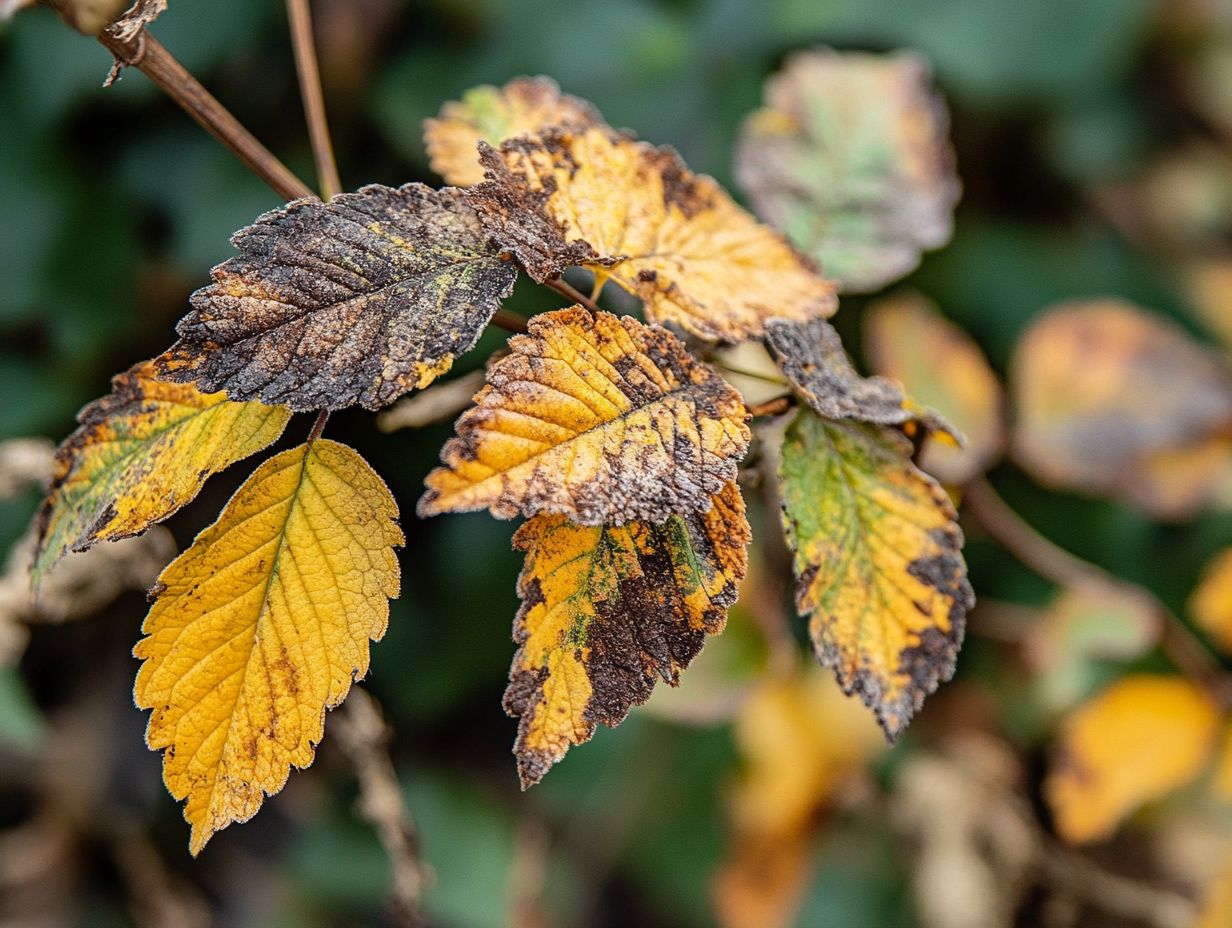
Bacterial diseases, such as bacterial wilt and gall formation, pose a significant threat to your winter crops. Infected plants may exhibit yellowing leaves and mushy spots.
These infections can lead to stunted growth and diminished yields, including brown spots on the crops. Ultimately, this impacts your livelihood as a farmer.
Bacteria spread through contaminated soil, water, and infected seeds. Knowing what helps them grow is essential for effective management.
Environmental factors like high humidity and temperature can worsen these issues, facilitating rapid disease advancement, including verticillium wilt.
To manage bacterial diseases effectively, practice crop rotation and maintain proper sanitation to prevent tuber disease.
- Crop rotation: Disrupts pathogen lifecycles.
- Maintain proper sanitation: Prevents the spread of infections.
- Select resistant crop varieties: Helps protect against disease.
Applying least-toxic and organic fungicides can effectively control these diseases, enabling your crops to thrive while minimizing environmental impact.
Viral Diseases
Viral diseases, such as the mosaic virus and black spot, pose a significant threat to a wide variety of plants. Symptoms include pale yellow spots and misshapen roots.
These infections can severely compromise a plant s vitality, making it more vulnerable to secondary infections and environmental stressors.
As a gardener or farmer, recognizing the early signs of viral infections, such as scabby spots, is essential for deploying effective management strategies.
To maintain the health of your plants, consider implementing the following control measures:
- Practice crop rotation: Disrupts pathogen lifecycles.
- Maintain strict sanitation protocols: Prevents the spread of infections.
- Employ insect control methods: Limits vectors like aphids, which are known to transmit these viruses.
Selecting disease-resistant varieties is also vital in safeguarding plant health. These cultivars can withstand or mitigate the effects of viral diseases, ultimately contributing to a healthier ecosystem.
Signs and Symptoms of Winter Plant Diseases
Recognizing the signs and symptoms of winter plant diseases, such as dark lesions and velvety spores, is crucial for effective management. By identifying issues early, you can take the necessary steps to safeguard your crops and plants.
Ensuring they remain healthy through the colder months is essential for a successful growing season.
Visual Indicators
Visual indicators such as dark lesions, dark water-soaked spots, and scabby patches are essential for diagnosing winter plant diseases early. These symptoms are vital clues to understanding your plants’ health during the colder months. They help identify wooden shrubs that may be affected.
Fungal diseases often show as dark, sunken lesions or fuzzy growths. Bacterial infections may appear as water-soaked patches or general browning of the tissue, including a dusty white coating on leaves. Viral infections frequently present with unusual mottling, curling leaves, or stunted growth, often seen with peach trees.
Learning to distinguish these symptoms, including reddish-orange spores, enhances your ability to identify the issues at hand. This knowledge empowers you to implement effective treatment strategies, ensuring that your affected plants are protected and revived.
Effects on Plant Growth and Health
Winter plant diseases can dramatically hinder your plants’ growth and overall health. They lead to stunted development, diminished yields, and, in severe cases, plant death, particularly affecting tomato fruits and peach trees if not addressed promptly.
These diseases disrupt your plants’ ability to photosynthesize, the process plants use to turn sunlight into energy. This is vital for healthy growth, affecting crops such as lettuce and kale. Infections can obstruct leaves, stem tissues, and roots, hampering nutrient uptake and compromising your plants’ vitality.
To effectively tackle these challenges, adopt proactive management practices. Use organic fungicides to remedy existing infections and establish a protective barrier against future threats. Incorporating crop rotation strategies helps prevent disease recurrence and fosters a healthier ecosystem, benefiting backyard peach and other stone fruits.
Preventing and Treating Winter Plant Diseases
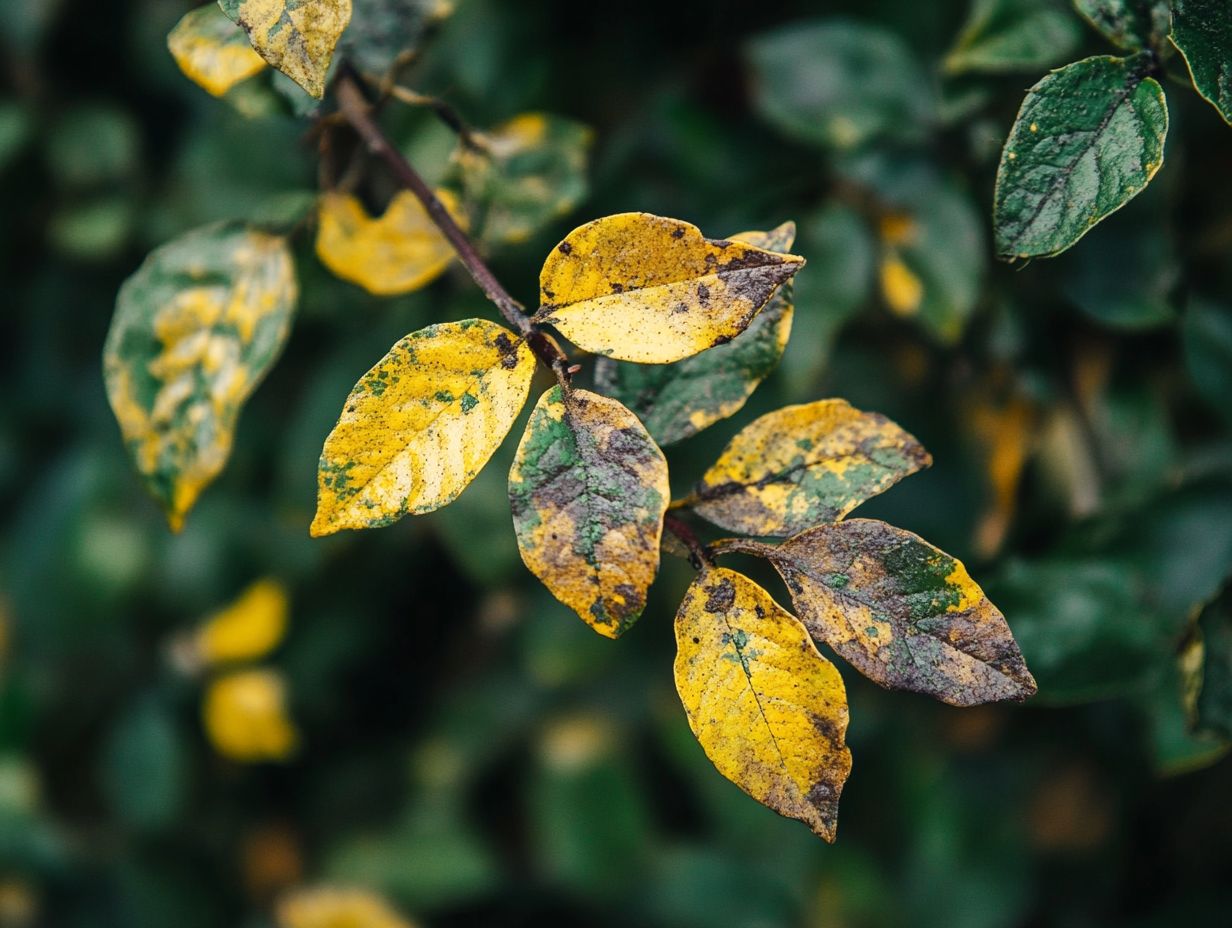
Preventing and treating winter plant diseases is crucial for maintaining your garden’s vitality, especially for crops like tomatoes and spinach. Effective strategies include:
- Crop rotation
- Rigorous sanitation practices
- Thoughtful application of least-toxic fungicides
These practices safeguard your plants and promote their health.
Effective Strategies for Prevention
Effective strategies for preventing winter plant diseases involve management practices that enhance plant health while minimizing pathogen exposure.
To ensure optimal growth, adopt proper watering techniques. Allow the soil to partially dry out between waterings to prevent excess moisture, which leads to dark water-soaked spots on plants and creates a breeding ground for disease. Avoid overcrowding plants to lower humidity levels, making it harder for harmful pathogens to thrive.
Selecting disease-resistant plant varieties provides extra protection against bacterial disease and common plant diseases. Implementing these practices cultivates an environment that fosters vigorous plant health, crucial for crops like tomatoes, peaches, and plums.
Act quickly and implement these strategies to keep your garden thriving and disease-free!
Treatment Options for Infected Plants
To treat infected plants, use least-toxic fungicides. Use methods like crop rotation to manage damping-off disease and avoid root rot.
Maintaining proper sanitation is vital. This prevents the spread of sooty mold and fusarium wilt.
Act quickly when diseases show up. Delays can lead to serious damage to your backyard peach trees and affect your entire garden ecosystem.
Pathogens like cladosporium and botrytis cinerea can threaten your plants. Consider using organic fungicides from natural sources; these can fend off pathogens while protecting beneficial organisms.
In addition to these treatments, use cultural practices to improve plant resilience. Proper watering techniques and adequate spacing promote good air circulation.
Keeping your tools clean and promptly removing diseased plant material is crucial. This reduces disease spread and creates a healthier environment for crops like spinach, lettuce, and kale.
Frequently Asked Questions
What are common winter plant diseases, including downy mildew and black spot?
Common winter plant diseases include powdery mildew, gray mold, and rust.
How can I identify common winter plant diseases like a dusty white coating on leaves?
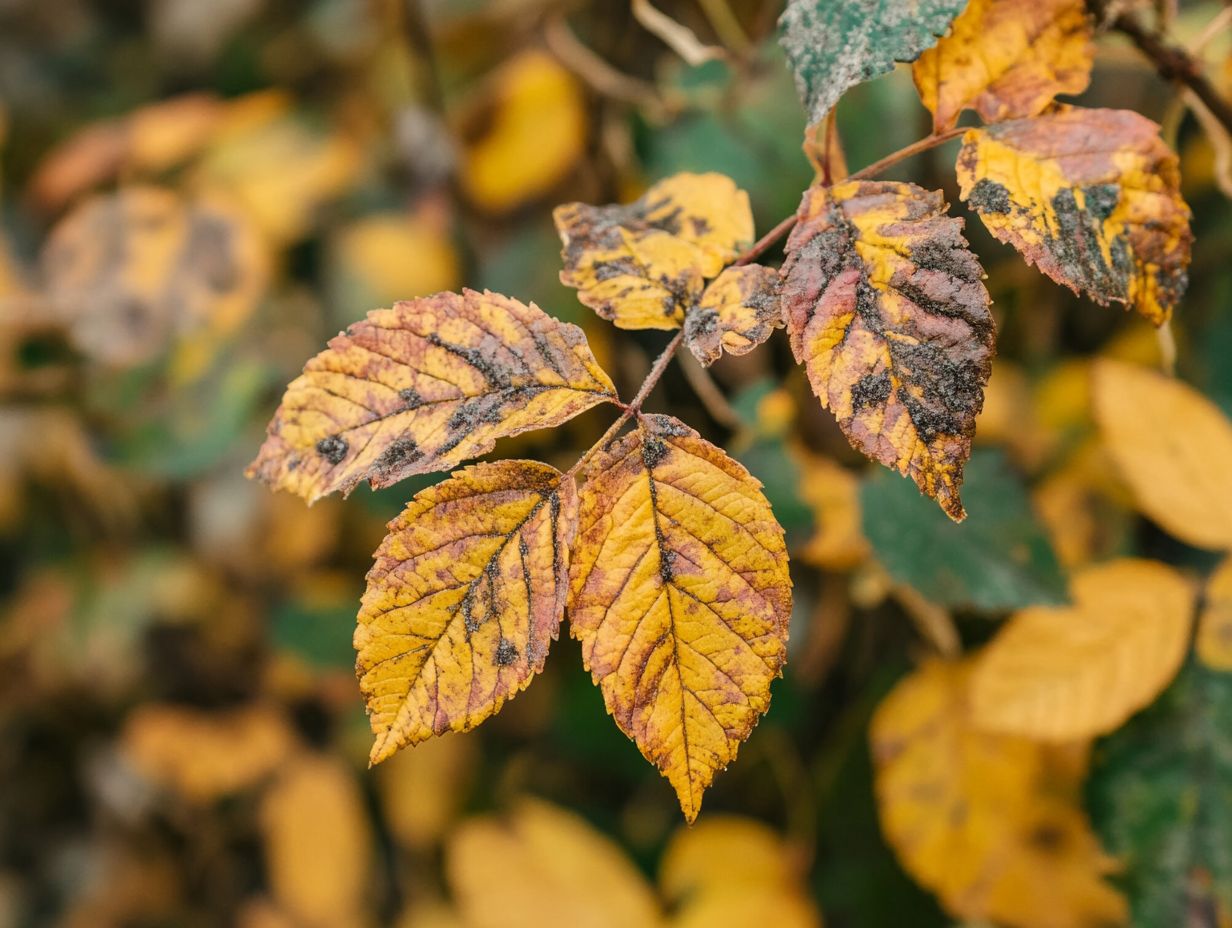
Look for discolored or wilting leaves, mold growth, and abnormal growth patterns.
What is powdery mildew, characterized by a dusty white coating, and how do I treat it?
Powdery mildew is a fungal disease that appears as a white powder on leaves. Remove infected leaves and apply a fungicide for treatment.
How can I prevent gray mold, often seen on woody shrubs?
Gray mold is caused by a fungus and spreads through poor air circulation and overwatering. Ensure your plants have enough space and avoid wetting the leaves when watering.
Are there any natural remedies for winter plant diseases, including organic fungicides?
Yes, natural remedies include neem oil, baking soda, or a mixture of water and vinegar. However, these may not be as effective as chemical treatments.
How can I protect my plants from winter diseases, avoiding light green patches and pale green spots?
To protect your plants, ensure they are healthy and well-maintained before winter. Avoid overcrowding and overwatering for optimal care.

